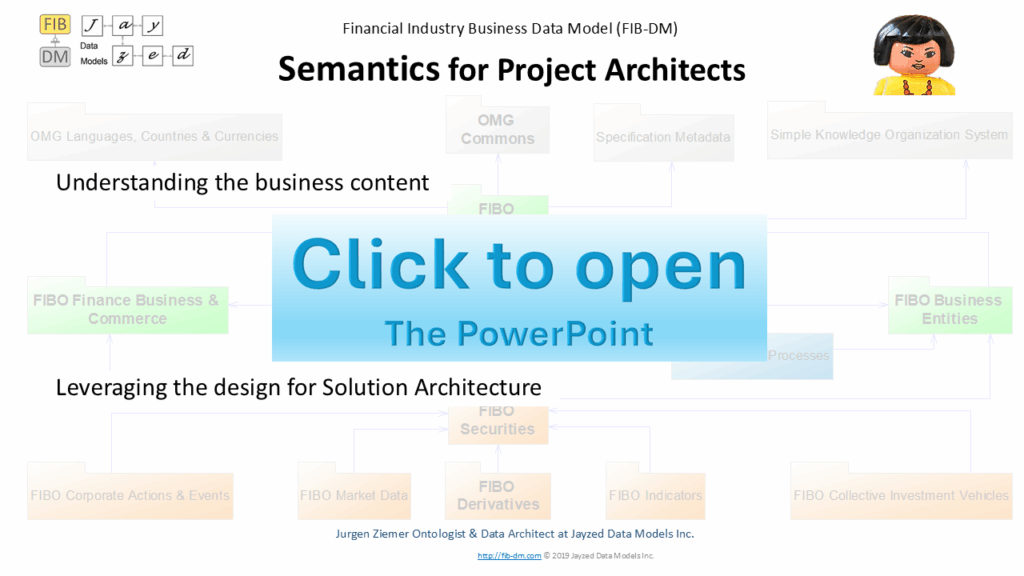Building an Enterprise Model is a considerable challenge, irrespective of the notation, Entity-Relationship or Ontology Web Language, OWL.
The vision is to achieve an immediate return on investment by using the reference model as an encyclopedia of building blocks, leveraging design patterns as blueprints for Solution Architecture, and reaping benefits from day one.
Solution Architects’ way is to follow the data model packages rather than fully rationalizing the concept hierarchies. We start with the package structure, and installments describe individual FIB-DM packages.

You can also download the tutorial in PDF or watch the webinar video.
Text of the Presentation
Financial Industry Business Data Model (FIB-DM) Semantics for Project Architects
Understanding the business content
Leveraging the design for Solution Architecture
Jurgen Ziemer Ontologist & Data Architect at Jayzed Data Models Inc.
© 2025 Jayzed Data Models Inc.
FIBO and FIB-DM are the Industry Standard
The Financial Industry Business Ontology (FIBO) is the blueprint for Enterprise Ontologies and the Knowledge Graph.
3,500 users downloaded the ontology-derived Financial Industry Business Data Model.
Education resources cover model structure, concept hierarchies, and the transformation process.
2
Education course for DAs, Stakeholders, and Ontologists
Project Data Architect experienced in logical and physical data modeling. You want copy design solutions for your department or sub-domain database.
Enterprise Data Architect experienced in industry reference models. You want to customize the industry-standard for your organization.
Finance / Business / Management. As a stakeholder, you want immediate returns without a huge investment.
Ontologist is responsible for operational and enterprise/knowledge graph ontology design. You want to understand FIBO modules.
3
The challenge: Building an Enterprise Model
Irrespective of the notation, Entity-Relationship (ER) or Ontology Web Language (OWL),
customizing the industry-standard reference model is herculean labor.
Hercules takes a break from cleaning the Augean Stables.
4
The vision: Immediate ROI
Using the reference Hercules removes a block. model as an encyclopedia
of building blocks.
Leveraging design patterns as blueprints for solution architecture.
ROI from day one.
5
The way: Two-pronged learning approach
Enterprise Architecture
Focus on hierarchies of the 15 Concepts and Associative Entities
Solution Architecture
Focus on FIB-DM packages (FIBO modules) for the project – not the whole model.
6
Business-driven, education course
The Enterprise Data Architect rationalizes the whole model, traversing the 15 concept hierarchies and the associative entities.
The Project Data Modeler wants to copy blueprints and design patterns for a specific business solution.
The Project/Solution track teaches the business content in detail.
You deep-dive into packages relevant to your project.
Project Architect © 2025 Jayzed Data Models Inc. 7
Monsters
Many Financial Institutions had multi-year,
multimillion-dollar failures creating an Enterprise Model.
Some comments called the 3,000-entity FIB-DM, the world’s largest data model, a monster.
A misconception of both the Financial Industry Business Data Model and Ontology. You can:
- Leverage the industry-standard as a reference model facilitating common names, definitions, design patterns, and reference data across the enterprise.
- Scope the Enterprise model of appropriate size.
- Use iterative development cycles (Spiral/Agile) harvesting tangible benefits for projects from day one.
Project Architect © 2025 Jayzed Data Models Inc. 8
An Encyclopedia can’t be too big
versus
We must not revert to rocket, balloon, and fairy
When in doubt – look it up in FIB-DM
9
Iterative development process (spiral or agile)
Determine objectives
Analyze & Mitigate (risks)
Entity Mortgage Cards
Cost for first iterations are low and remain under control
Plan next iteration
Model, Develop & Test
Deliverables provide a cumulative benefit
10
Data Model Education Resources (info cards)
Title
Frontpage
Intended Audience, main and optional
Resource Type:
PowerPoint
Video
Article or Whitepaper
Data Architect Ontologist © 2025 Jayzed Data Models Inc. 11
Education path for Project Architects
Semantics for Finance Users
Semantics for Mid-size Banks
I. Open Source Model for Financial Industry
Semantics for Large Banks (open banking)
Semantics for Managers
Semantics for XL Banks (transformations)
- You should watch and study the general introduction to the data model, Finance, and applicable midsize, large or extra-large bank first.
- Then progress to Semantics for (all) Data Architects, and most important, Scoping Data Models from FIB-DM.
- The in-depth treatment of ontology to data model mapping and transformation is optional.
- Finally, study this overview of FIB-DM packages and deep-dives into subject areas.
Semantics for Data ArchitectsII. Ontology = Data Model Hierarchy
Semantics for Project Architects
Scoping our first Data ModelIII. Object Properties = Associative Entities
FIBO/FIB-DM Foundations
Normative and Informative Data ModelIV. Data Model -> Ontology
FIBO/FIB-DM Business Entities
Project Architect © 2025 Jayzed Data Models Inc. 12
Resources and next steps
The FIB-DM website:
• PowerPoints for viewing and download • Deep-dive articles
• Scalable SVG diagrams of packages and the complete subtype hierarchies.
Follow the FIB-DM LinkedIn page for news, updates and to read and share comments. https://www.linkedin.com/showcase/fib-dm/
Watch FIB-DM Education videos on YouTube. https://www.youtube.com/c/fibdm
Evaluate the 1,029-entity Core Model
Upgrade to the latest
3.212-entity Full Version
Ask your questions or schedule a meeting. jziemer@jayzed.com
13